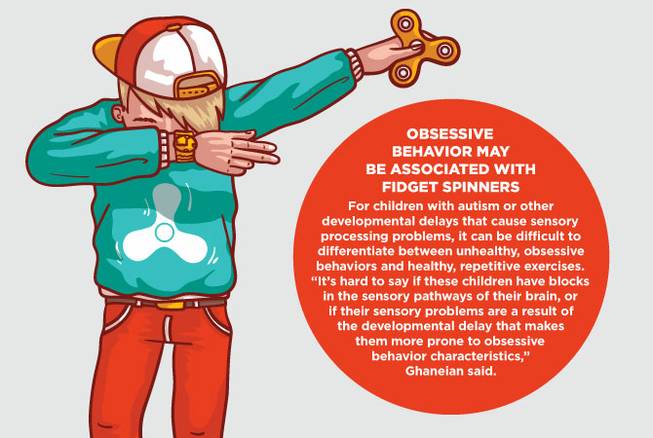
Monday, July 10, 2017 | 2 a.m.
There’s no denying the popularity of fidget spinners. You can find them anywhere — from toy stores to gas stations to online specialty shops — and their appeal spans all age groups.
Marketed as a stress-relieving toy, manufacturers claim that fidget spinners can help improve focus and ease anxiety by redirecting emotional stress into repetitive physical movements. It’s also asserted that fidget spinners can be beneficial for kids with ADHD, autism and other special needs, but the toys have been banned in classrooms across the country because of the distraction they pose for students.
With so much apparent contradiction and controversy surrounding fidget spinners, it begs the question: How many of these claims actually hold weight?
“Currently, there is no evidence-based medicine to support the claims,” said Atousa Ghaneian, MD, FAAP at Healthy Kids Pediatrics and Sunrise Children’s Hospital. While the claims may be unproven, according to Ghaneian and her business partner, Lesa Brookes, MD, FAAP, there are appropriate uses for fidget spinners.
If you, your child or other family members have hopped on the fidget spinner bandwagon, it’s important to understand why the toy is so engaging — and when engagement crosses into unhealthy obsessive behavior.
What is a fidget spinner?
A fidget spinner is a flat, two- or three-pronged, ball-bearing toy that you rotate between your fingers to make it spin. It’s typically made of plastic and metal, and some models come equipped with decals and flashing lights.
Is it a sensory toy?
Sensory toys often are used to help develop motor skills in young children and for therapeutic purposes in children with autism and developmental disorders. Some find sensory toys to be beneficial because they promote sensory processing and integration using visual, tactile and auditory stimuli.
“There are a variety of sensory toys out there ranging by age. Anything from rattle balls for infants to play gyms for toddlers to swings and balls for older kids,” Ghaneian said.
While fidget spinners are often touted as a sensory toy, this may not be the case. “I think it’s too soon to officially categorize fidget spinners as a sensory toy,” Ghaneian said. Further, “there isn’t enough medical research about sensory toys. Some kids may find them emotionally soothing while others might just find them intriguing and distracting.”
Promoting attentiveness vs. creating distractions
Some find fidget spinners to increase attentiveness whereas some find them distracting. While it depends on the person and his or her personal experience, there is no clinical research to favor the argument that these toys promote attentiveness.
Ghaneian and Brookes theorize that many of these claims are anecdotal — stemming from reports made by therapists or patients — and are therefore subjective. However, there is some evidence to suggest that children with ADHD benefit from background activity. While fidget spinners might qualify as an example of background activity, they have not been used in any of the relevant studies.
For most children, it’s likely that fidget spinners are more distracting than they are beneficial.
“Oftentimes, children lose focus rather than gain it, which is the primary reason many schools have banned the toy. Fidget spinners can even distract from basic daily functions, such as walking or being aware of your surroundings, which can lead to injury,” Ghaneian said.
“Some behavioral or occupational therapists may use them with children as they do with other tools, like stress balls, but that’s in a controlled environment and for a set amount of time. This is unlike children who play with the gadgets for hours on end at home, in day care or in school.”
Obsessive behavior may be associated with fidget spinners
For children with autism or other developmental delays that cause sensory processing problems, it can be difficult to differentiate between unhealthy, obsessive behaviors and healthy, repetitive exercises. “It’s hard to say if these children have blocks in the sensory pathways of their brain, or if their sensory problems are a result of the developmental delay that makes them more prone to obsessive behavior characteristics,” Ghaneian said.
How to keep your fidget spinner-loving kids safe
While fidget spinners aren’t likely to live up to their grander claims, they can still be a fun and safe toy for many children. It’s important that parents simply monitor and limit their child’s use of the toy when necessary.
1. Limit playtime. Children should not have a fidget spinner in hand during all hours of the day. Make sure they’re playing with it for only a couple of hours daily and aren’t doing so during other activities.
2. Keep them away from toddlers and young kids. Fidget spinners can break apart and cause serious choking hazards. This also can be dangerous for children with developmental delays, who might swallow a dislodged part of the toy. To ensure you’re buying a quality fidget spinner, only shop with reputable retailers and look for age and safety labeling that’s consistent with other toys on the market.
3. Avoid electronic models when possible. There has been a recent string of fidget spinners with batteries catching fire while charging, and some devices with flashing lights may cause seizures in children with epilepsy.

Join the Discussion:
Check this out for a full explanation of our conversion to the LiveFyre commenting system and instructions on how to sign up for an account.
Full comments policy